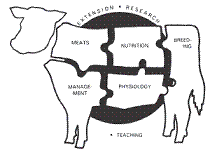Animal Science, Department of
Date of this Version
January 1996
Abstract
Two trials were conducted to evaluate the use of dried poultry waste as a source of degradable intake protein in growing and finishing ruminant diets. Trial 1 utilized eight-eight crossbred lambs (62 lb) in a 60-day growing period and subsequent 60-day growing period and subsequent 60-day finishing period. In the growing period, lambs were fed seven levels of degradable intake protein, 5.6 to 7.7% of diet DM (7.6 to 9.7% CP) from either urea or dried poultry waste. In the finishing period, lambs (71 lb) were fed a control diet containing no added N, 4.1% degradable intake protein (9.6% CP) or six levels of degradable intake protein, 4.7 to 8.5% (10.1 to 12.6% CP) from either urea or dried poultry waste. In the growing phase, no response to level of degradable intake protein was observed. Feed efficiencies for urea and dried poultry waste were equal. In the finishing phase, dried poultry waste was equal to urea as a source of degradable intake protein. In Trial 2, four ruminally-fistulated crossbred yearling steers (642 lb) were used to evaluate rumen ammonia concentration from feeding dried poultry waste or urea. Steers were ruminally dosed with .08 lb of nitrogen from either urea or dried poultry waste. Steers dosed with urea had greater ammonia concentration at two and four hours compared to those dosed with dried poultry waste. Dried poultry waste was utilized a effectively as urea in growing and finishing lamb trials and concentration of ammonia in the rumen was less for dried poultry waste.



Comments
Published in 1996 Nebraska Beef Cattle Report; published by Agricultural Research Division, Institute of Agriculture and Natural Resources, University of Nebraska-Lincoln.